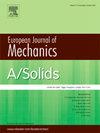High-frequency mechanical impedance of rubber mounts: Experimental characterization and resonance mechanisms
IF 4.4
2区 工程技术
Q1 MECHANICS
引用次数: 0
Abstract
The characterization of the dynamic behavior of rubber anti-vibration mounts in electric motor systems is crucial for optimizing the vibro-acoustic performance of electric vehicle interiors. The transition to electric propulsion has revealed new high-frequency vibration sources (up to 3 kHz), including electromagnetic harmonics from motor commutation. Addressing these vibrations is essential to improve passenger comfort and promote the adoption of electric vehicles. This study presents an in-depth investigation into the dynamic response of cylindrical rubber mounts, employing a custom-designed test rig capable of evaluating performance up to 3 kHz. The experimental setup follows the UNE-EN ISO 10846 standard to ensure accurate measurements of vibro-acoustic transfer properties. To minimize high-frequency transmission through the test bench structure, a seismic mass serves as a decoupling element and stable reference. Force sensors are integrated into the seismic mass, ensuring that measured forces correspond solely to those applied to the rubber specimen, thus isolating the results from structural influences. The experimental findings reveal significant deviations in both the mechanical impedance modulus and the offset angle compared to behaviors observed at lower frequencies, which have been the primary focus of previous studies on vehicles with internal combustion engines. At low frequencies, stiffness-dominated behavior prevails; however, at higher frequencies, inertial effects and wave propagation phenomena become significant, altering the stiffness modulus curve and leading to the appearance of a peak characteristic of a resonance frequency. High-frequency responses are further analyzed through implicit harmonic analysis using advanced finite element modeling techniques. The experimental results are validated through this analysis, as the frequency at which the observed peak occurs coincides with a resonance frequency of the component identified in the harmonic analysis. Furthermore, this research demonstrates that these resonances, along with wave propagation effects, contribute to a complex deformation field, potentially accelerating material degradation and failure, addressing the importance of optimizing the design of these components to enhance their durability and performance.
橡胶支架的高频机械阻抗:实验表征和共振机制
电机系统中橡胶减振支架的动态特性表征对于优化电动汽车内饰的振动声学性能至关重要。向电力推进的过渡揭示了新的高频振动源(高达3khz),包括电机换向产生的电磁谐波。解决这些振动问题对于提高乘客舒适度和促进电动汽车的采用至关重要。本研究对圆柱形橡胶支架的动态响应进行了深入研究,采用了定制设计的试验台,能够评估高达3 kHz的性能。实验设置遵循UNE-EN ISO 10846标准,以确保振动声传递特性的准确测量。为了最大限度地减少通过试验台结构的高频传输,地震质量可以作为解耦单元和稳定参考。力传感器集成到地震质量中,确保测量的力仅与施加在橡胶试件上的力相对应,从而将结果与结构影响隔离开来。实验结果表明,与在较低频率下观察到的行为相比,机械阻抗模量和偏移角都存在显著差异,这是之前内燃机车辆研究的主要焦点。在低频时,以刚度为主;然而,在更高的频率下,惯性效应和波传播现象变得明显,改变了刚度模量曲线,导致共振频率出现峰值特征。利用先进的有限元建模技术,通过隐式谐波分析进一步分析高频响应。通过该分析验证了实验结果,因为观察到的峰值发生的频率与谐波分析中确定的分量的共振频率一致。此外,该研究表明,这些共振以及波传播效应会导致复杂的变形场,可能会加速材料的退化和失效,从而解决了优化这些部件设计以提高其耐久性和性能的重要性。
本文章由计算机程序翻译,如有差异,请以英文原文为准。
求助全文
约1分钟内获得全文
求助全文
来源期刊
CiteScore
7.00
自引率
7.30%
发文量
275
审稿时长
48 days
期刊介绍:
The European Journal of Mechanics endash; A/Solids continues to publish articles in English in all areas of Solid Mechanics from the physical and mathematical basis to materials engineering, technological applications and methods of modern computational mechanics, both pure and applied research.

 求助内容:
求助内容: 应助结果提醒方式:
应助结果提醒方式:


